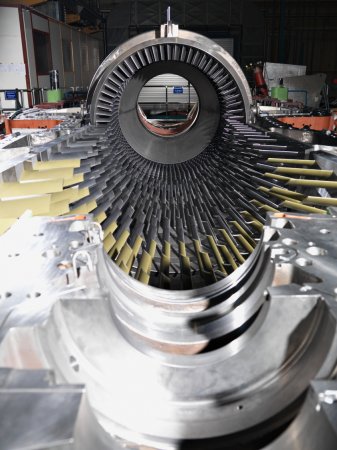-
Gas turbine plant
Definition
One of a class of heat engines that converts the energy of fuel into work by using compressed, hot gas as the working medium and that usually delivers its mechanical output power either as torque through a rotating shaft (industrial gas turbines) or as jet power in the form of velocity through an exhaust nozzle (aircraft jet engines). Also known as combustion turbine. The fuel energy is added to the working substance, which is gaseous in form and most often air, either by direct internal combustion or indirectly through a heat exchanger. The heated working substance, air co-mixed with combustion products in the usual case of internal combustion, acts on a continuously rotating turbine to produce power.
Function
Gas turbine engines depend on the principle of the air cycle, where, ambient air is first compressed to a maximum pressure level, at which point fuel heat energy is added to raise its temperature, also to a maximum level. The air is then expanded from high to low pressure through a turbine. The expansion process through the turbine extracts energy from the air, while the compression process requires energy input.
If the thermal cycle is of open type, the gas turbine delivers only mechanical power which can be used to drive pumps (feed water pumps of thermal power plants) or an electric generator (energy production).
If the thermal cycle is of close type, the heat of turbine exhaust gases is reused either to produce direct heat through a heat exchanger or to increase the efficiency of a second thermal cycle (CHP: combined heat plants).
Basic components
The basic components of a gas turbine are:
- the reduction gear box with its outlet shaf,
- the turbine main shaft with its bearings,
- the air inlet compressor,
- the combustion chamber,
- the combustion chamber,
- the turbine
- the exhaust gas diffuser,
- the generator,
- the turbine controls, generator control panel, motor control center for package motors and variable speed drive for starter motor are normally also package-mounted.
In high power gas turbines, the turbine includes several pressure reducing stages. The first stage is fit with fins internally cooled. Also, water injection devices are added in view to limit the gas temperature in combustion chamber and the amount of thermal NOx produced.
The rotation speed of turbine ranges from 3000 rpm (large gas turbine) till 26000 rpm (little single stage turbine including a reduction gear box).
The temperature of exhaust flue gas ranges from 370 till 620°C following the type and the size of the gas turbine.

General arrangement of a gas turbine
Source © OPRADifferent types of gas turbines
Industrial (heavy duty) gas turbines
They differ from aeronautical designs in that the frames, bearings, and blading are of heavier construction. They are also much more closely integrated with the devices they power—electric generator—and the secondary-energy equipment that is used to recover residual energy (largely heat).

Gas turbine - stationary lower half of compressor
equipped with blades, Mannheim, GermanyPhotographie publiée sur notre site avec l’aimable autorisation d’Alstom, reproduction interdite.
Photograph published on our site with courtesy of Alstom, reproduction prohibited.Aeroderivative gas turbines
Aeroderivatives are used as turbojets in aircraft field but also in electrical power generation due to their ability to be shut down, and handle load changes more quickly than industrial machines. They are also used in the marine industry to reduce weight. The General Electric LM2500, General Electric LM6000, Rolls-Royce RB211 and Rolls-Royce Avon are common models of this type of machine.

Aeroderivative gas turbine
Source : General Electric

